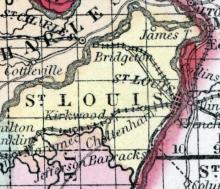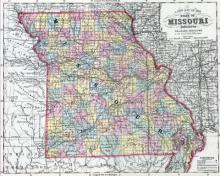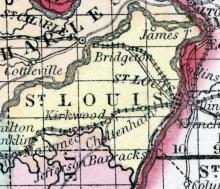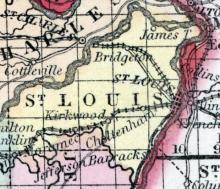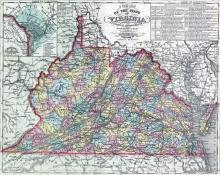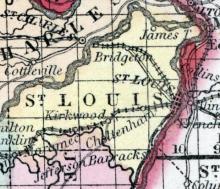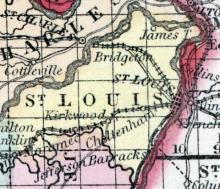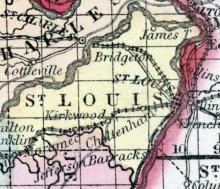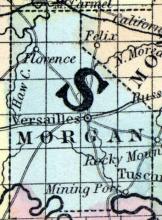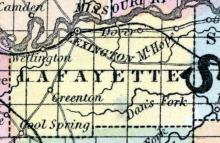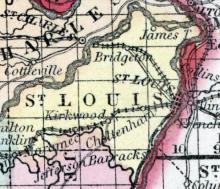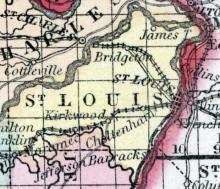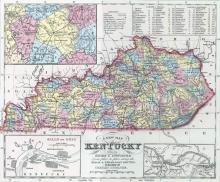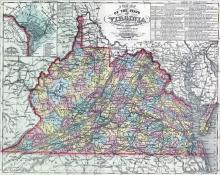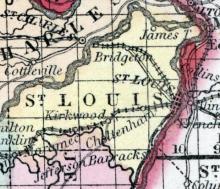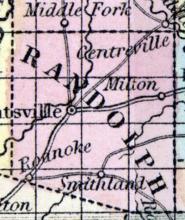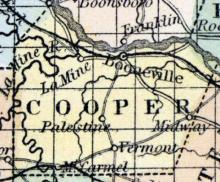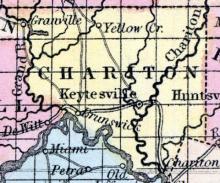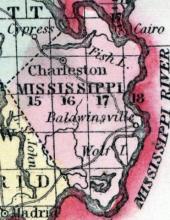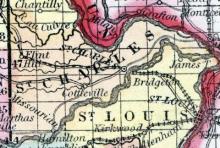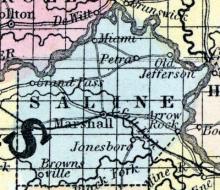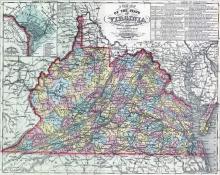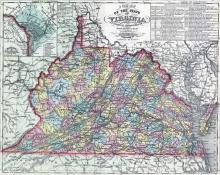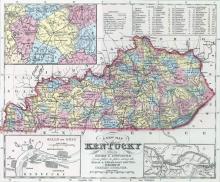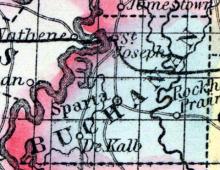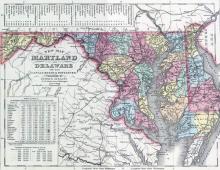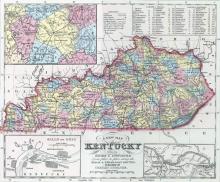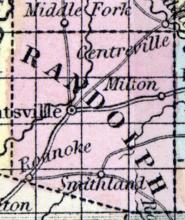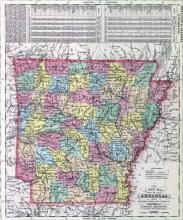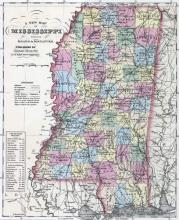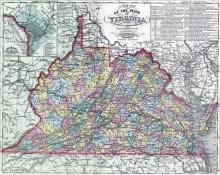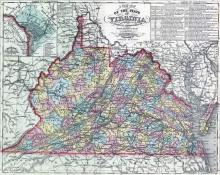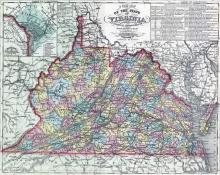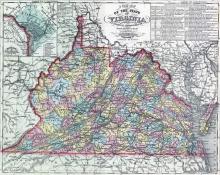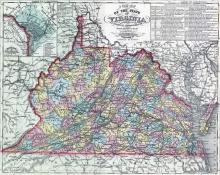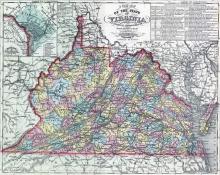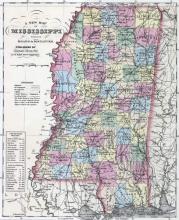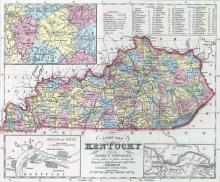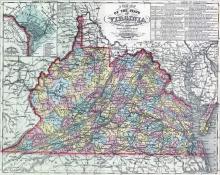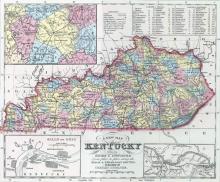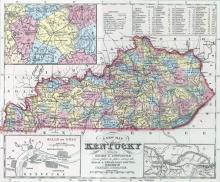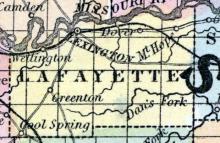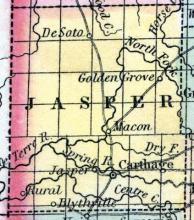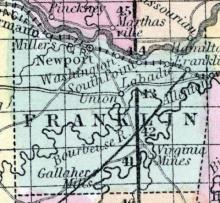On Monday, December 4, 1854, a 20-year-old enslaved man named Moses escaped from St. Louis. His enslaver, W.G. Gibbs, advertised a $200 reward for Moses's recapture.
View All Escapes // 1840s // 1850s // 1860s
Displaying 151 - 200 of 476
On Sunday, December 24, 1854, two enslaved men, Richard Wash and Robert Jones escaped from the steamboat Tropie, while it was docked at Cairo, Illinois. Their enslavers, Henry E. Moore of Boonville, Missouri and B.M. Lynch of St. Louis, advertised a $250 reward for their recapture.
In early 1855, two enslaved Missourians were recaptured aboard a train outside of Sandoval, Illinois. The pair of freedom seekers had been reportedly "abandoned" by abolitionists, and were recaptured and taken to Cairo, Illinois.
On Saturday night, January 27, 1855, a "serious stampede" rocked Richmond, Virginia. Five enslaved people, among them Bob, Joe, and Linsey, escaped for "parts unknown," armed with $1,500 in cash taken from one of their slaveholders. Indeed, Bob, the enslaved man who fled from the slave trading firm of Jones & Slater had "enjoyed their fullest confidence," and was entrusted with making regular bank deposits for the slave traders.
On Thursday, February 15, 1855, 40-year-old Sarah escaped from slavery with her ten-year-old son Dick after their slaveholder, Legrand F. Rucker, died. The executor of Rucker's estate, Joseph H. Locke, advertised $300 for their recapture.
On Sunday night, February 18, 1855, six enslaved people, a man, woman and four children, escaped from prominent St. Louis slaveholder John O'Fallon. Missouri papers speculated that the freedom seekers were "on the way to Chicago."
On Tuesday, February 20, 1855, days after the escape of six enslaved people from slaveholder John O'Fallon, three more enslaved people escaped from St. Louis. Two were held by a Mr. Coleman, a few miles from St. Louis on the Bonhomme road, while another was enslaved in St. Louis itself.
On Tuesday, February 20, 1855, two enslaved people escaped from Richmond, Virginia, on the heels of another "stampede" of five freedom seekers the previous month. Their fate is unknown.
On Saturday morning, March 31, 1855, a 16-year-old enslaved woman escaped from St. Louis. Her name is unrecorded. Her enslaver, William Few, advertised requesting information regarding her whereabouts.
In one night in early April 1855, six enslaved people escaped from St. Louis.
On Sunday April 22, 1855, two enslaved men, William Taylor and William Bruce, escaped from slaveholder John Lay's property three miles outside St. Louis on the Central Plank Road. Lay advertised an $800 reward for their recapture.
An enslaved man named Jackson, also called Bob by his enslaver, escaped from Versailles in Morgan county, Missouri. His enslaver, Francis L. Ross, advertised a $50 reward for Jackson's recapture.
Around mid-May 1855, four enslaved people, 23-year-old Don, 30-year-old Hal, 28-year-old Bill, and 40-year-old Randall, escaped from near Lexington, Missouri. Their enslaver, Nathan Corder, advertised a $400 reward for their recapture.
On Sunday, May 20, an enslaved man named Jim Kennerly, around 20 years old, escaped from slaveholder Henry Shaw's "country residence" outside St. Louis. Shaw advertised a $300 reward for Jim's recapture. This episode was part of the 1855 St. Louis Stampede.
On Sunday, May 20, 1855, a roughly 22-year-old enslaved man named Ben escaped from St. Louis. His enslaver, H.H. Cohen, advertised a $100 reward for his recapture. This episode was part of the 1855 St. Louis Stampede.
On Sunday evening, May 21, 1855, around eight enslaved Missourians escaped via boat from St. Louis, with the aid of Mary Meachum, a prominent free African American in the city. However, authorities were waiting on the opposite shore, and five of the escapees were recaptured. Meachum and two other free blacks were later charged with assisting the escapees to flee.
On Wednesday night, June 6, 1855, a group of enslaved people escaped from the Byrnes plantation in Bourbon county, Kentucky. When the slaveholder, Byrnes, attempted to stop the escape, a violent confrontation ensued, where the enslaver was "severely handled" and left unconscious on the ground. The number of freedom seekers, or their names, were not recorded, but they reportedly crossed the Ohio river "about ten miles below" Cincinnati.
On Saturday night, June 16, 1855, five enslaved people escaped from Norfolk, Virginia. Attempting to escape aboard a northern-bound ship, they were betrayed and turned over to local authorities. Then on Sunday morning, June 24, another group of 15 freedom seekers escaped by boat from Norfolk. Their fate is unknown, but later in September several freedom seekers from Norfolk appeared in Syracuse, New York. They may have been from this second group of runaways.
Three enslaved people, Fayette, Madison and Thomas, escaped from St. Louis sometime during the mid-1850s, and settled in Chicago. The slaveholder who claimed Fayette and Madison, a man named Peter Camden, tried repeatedly but unsuccessfully to recapture the three escapees.
On Sunday July 29, 1855, three enslaved men, Henry Corder, Bill Coger, and Sam, escaped from Boonville, Missouri. Their enslaver, Henry E. Moore, offered a $450 reward for their recapture.
An enslaved man named Joseph fled from slaveholder Thomas Rodney in August 1855, boarding the Illinois Central Railroad at Cairo and riding the train to Chicago. Joseph was never recaptured, but an irate Rodney sued the railroad in Illinois state court, but lost.
An enslaved man named Jim escaped from Flint Hills, Missouri, reportedly making his way into Calhoun county, Illinois, along with a "man called Irish John or John Doyle." His enslaver, B. English advertised a $500 reward for his recapture.
Three enslaved people, a 24-year-old man, an 18-year-old woman, and another woman of unspecified age, escaped from Arrow Rock in central Missouri. Their enslaver, James W. Dickinson, advertised a $100 reward for their return.
On Sunday, August 19, 1855, six freedom seekers, who were not named, escaped from Piedmont, Virginia. They fled from enslavers Isaac Parsons, G.W. Blue, G.W. Washington, William Donaldson, and Isaac Baker. Their fate remains unknown.
In the span of about two weeks in early September, around 15 to 20 enslaved people escaped from Loudon county, Virginia, in what a local paper called a "wholesale stampede." The names of the freedom seekers were not recorded, but four individuals escaped from slaveholder John M. Harrison, three from a man named Skinner, three from a slaveholder named Stevenson, two from Joseph Lodge, and one from Cornelius Vandoventer, one from Joseph Meade, one from C. R. Dowell, one from Dr. F.
During the late summer and early autumn of 1855, there were numerous "stampedes" from Trimble county, Kentucky. A Madison, Indiana newspaper reported that there were "almost daily" escapes, and noted the escape of two freedom seekers held by Dr. William Ely of Milton, Kentucky.
On Saturday night, September 15, 1855, a group of freedom seekers escaped from near Chestertown, Maryland, traveling via three horses and a carriage. Accounts vary about the size of the group, alternating between 10 and 21 people.The freedom seekers passed through Rochester, New York, where Frederick Douglass announced in his newspaper that he had "the pleasure of shaking seven of them by the hand," before the freedom seekers reportedly journeyed on to Canada.
Between Friday night, September 21 to Tuesday September 25, the Louisville Courier tallied seven enslaved people who had escaped from near Louisville, Kentucky. The ultimate fate of the seven freedom seekers remains unknown, but the "regular and constant stampede" clearly unnerved Louisville's slaveholding class.
On Sunday, September 23, 1855, a 36-year-old enslaved man named Charles escaped from Huntsville in Randolph county, Missouri. His enslaver, James H. Britton, advertised a $150 reward for Charles's recapture.
Sometime in early October 1855, 11 enslaved people escaped from Ouachita county, Arkansas. A "general stampede among the negroes" was feared, and slaveholders feared "a concert of action" among local enslaved people. The fate of the 11 freedom seekers, however, remains unknown.
In October 1855, a correspondent to the Vicksburg, Mississippi Whig mentioned a "general stampede" of "some ten or fifteen" enslaved people from near Raymond, Mississippi. The enslaved people had apparently been hired out ("or rented") by slaveholders in Raymond, and the "stampede" may have been connected to a fever outbreak.
On Saturday night, October 27, 1855, seven enslaved people broke open a locked door and escaped from the slave pen of Jones & Slater in Richmond, Virginia. Three of the freedom seekers had been arrested previously, after attempting to escape from Bath county, Virginia. They were slated to be sold south.
Sometime in November 1855, a group of freedom seekers escaped from Union in Monroe county, Virginia. The number of runaways was not specified, nor were their names recorded, but reports did specify that the slaveholder, J.L. Hutchinson, lost $2,000 in human "property."
On Saturday night, November 3, 1855, six enslaved people, heavily armed, mounted horses near Fairmont, Virginia and galloped northwards towards freedom. One man was recaptured, but the remainder apparently eluded re-enslavement, despite their enslavers offering a $1,000 reward for their recapture.
Sometime in mid-November 1855, some 18 enslaved people--both men and women--escaped from Portsmouth and Norfolk, Virginia. Their fate remains unknown, but the escape did prompt concerned slaveholders to contemplate forming a squadron of slave patrolling vessels.
On Saturday night, November 24, 1855, six freedom seekers, who were not identified by name, escaped from Richmond, Virginia. Their destination is unknown, but Richmond journalists suspected that they had traveled along the "underground railroad, and are now, no doubt, on their way to the North."
On Saturday, December 1, 1855, some 11 enslaved people--seven men and four women--escaped from Richmond, Virginia. Their fate remains unknown.
Sometime in December 1855, some 40 enslaved people escaped in a "stampede" from Natchez, Mississippi. According to the Memphis, Tennessee Appeal, suspicions ran high that the freedom seekers "were carried off by some up-river boat, in the hands of Abolitionists of negro thieves." But the mode of escape, or ultimate fate of the freedom seekers remains unknown.
On Sunday night, December 16, 1855, seven enslaved people escaped in a "splendid carriage" from Millersburg in Bourbon county, Kentucky. But on attempting to cross the Ohio river near Maysville, their skiff leaked and filled with water, tragically drowning a woman and her three children. The survivors were re-enslaved.
On Christmas Eve 1855, six enslaved people--four men and two women--escaped from Middleburg in Loudon county, Virginia. Traveling on horseback and in a carriage, and heavily armed, the freedom seekers passed near Hood's Mill (near Eldersburg), Maryland the following day, where white residents sounded the alarm and started in pursuit. They shot and wounded one of the freedom seekers, and recaptured him, and later recaptured another of the men, who was named Joe.
In one of the most famous and tragic episodes of the fugitive slave crisis, a group of 16 freedom seekers escaped from Boone county, Kentucky on Sunday, January 27, 1856. After crossing the Ohio river, eight members of the Garner family were overtaken by a posse of slave catchers and federal officers. Forced to surrender, freedom seeking mother Margaret Garner killed her young child, rather than see the child be returned to the horrors of slavery.
Throughout late January and early February 1856, enslaved people launched a startling series of "stampedes" from Boone county, Kentucky and the surrounding counties. The Ohio river had frozen, temporarily forming an icy "bridge," and enslaved Kentuckians seized the moment for a mass exodus from bondage. Some estimates place the number of freedom seekers as high as 200 during this period.
On Friday night, February 1, 1856, six enslaved Kentuckians were "taken with a sudden leaving" and escaped into Ohio. They likely crossed the river by way of the "icy bridge" that frigid winter conditions had created, near California, Kentucky. Their ultimate fate remains unknown.
Around March 15, 1856 a 22-year-old enslaved man named Ned escaped from Berlin, Missouri. His enslavers, the firm Gratz & Shelby, advertised a $100 reward for his recapture.
Sometime in mid-April 1856, 30 enslaved people escaped from Asheville, North Carolina, bound for "parts unknown." They were claimed by slaveholder Samuel S. Simmons. An Asheville journalist remarked on this "stampede," noting: "This is 'running away' by the wholesale."
An enslaved man named Dow, about 23 years in age, escaped from Blytheville (modern day Union City) in what was then Jasper county, Missouri. His enslaver, John C. Cox, advertised a $300 reward for his recapture.
An enslaved lead miner named John Huddin escaped from Virginia Mines in Franklin county, Missouri on Saturday, June 7, 1856.


